Digital devices can be classified according to various criteria. So, in general, at the input of a digital device p, and at the exit - t variables, i.e. present accordingly p- and m-bit codes. Therefore, digital devices can be classified by the method of input-output variables (information). From this point of view, they are divided into sequential, parallel and sequentially parallel (mixed).
This is a lesson in various classifications of numbers, which is basically a big word, simply saying that numbers are part of families, and numbers have different houses depending on what number they are, like people. You do not give them your specific address. As for the numbers of things, the most basic number is number 1, and the most specific descriptor of where he lives is called. Natural numbers are also sometimes called counting numbers, because they are the first numbers that you will learn how to count.
But the opposite is not necessarily true, because not everyone who lives in Santa Clara County lives in Cupertino, so you need to be careful when going back and forth. The numbers are the same. If we get a slightly lower specific gravity, then what we get are called integers. All natural numbers are part of the integer, just as all people who live in Cupertino also live in Santa Clara County. But there is one integer that is not a natural number. Therefore, when we talk about integers, we are talking about numbers starting at 0 and starting to rise 1, 2, 3 and on and on.
Consistent called a device in which the input variables are fed to the input, and the output variables are removed from the output not simultaneously, but sequentially, bit by bit.
Parallel called a device in which all bits of the input variables are fed to the input and all bits of the output variables are removed from the output simultaneously.
Taking another step in my situation, Cupertino and Santa Clara are part of California. Again, not everyone who lives in California lives in Santa Clara or, more precisely, in Cupertino. But if you live in Cupertino or Santa Clara, you definitely live in California.
The conclusion in the direction of numbers leads us to what is called integers. Again, not all integers are integers and natural numbers. But all integers and natural numbers are integers. This trend continues with numbers. When we take another step back, we come to what is called. New additions to the club are fractions.
IN series parallel devices, input and output variables are presented in various forms. Either variables are input to the input sequentially character by character, and they are removed from the output simultaneously or vice versa.
According to the principle of operation, all digital devices are divided into two classes: combinational and serial.
The list is getting a little harder to write, but again, you can imagine that there are many different types numbers. It is still true that all the previous numbers that we mentioned are rational, but not all rational ones, in particular these fractions, are part of integers, integers or natural numbers.
But they are in another group. For example, for people living in Japan or France, you do not live in America, so you are part of a separate group. The same thing happens as numbers. There is a separate group of numbers that do not correspond to the rest. Irrational numbers are all numbers that cannot be called fractions.
Raman digital devices or devices without memory are called digital devices whose output signals are uniquely determined only by the combination of variables that is currently valid at the input and do not depend on the values \u200b\u200bof the variables that acted on the input earlier.
Sequential devices, or automatic devices with memory, are called digital devices, the output signals of which are determined not only by the combination of variables that is currently active at the input, but also by the entire sequence of input variables that were in effect at previous times. This type of device is often called digital vending machines.
There are many different numbers. Another is the square root of 2, which is something like 4, but again, the decimal digit goes on forever, and there is no fraction that could represent it. These irrational numbers are their own group. They are not part of rational or natural or integers; they are not connected, but separated.
I do not like to end the story of separatism. No matter what country you live in, we are all inhabitants of planet Earth. They are happy and they like to be together. They all live under the banner of the so-called real numbers. The irrational and rational combine, and together with them they form real numbers.
26.2 Ktsu implementing elementary logical functions
As a rule, such microcircuits contain several elements of the same type. The correspondence between the logical functions performed by the microcircuits and the letters with which they are encoded is given in table 26.1.
Table 26.1 - Designations of logical elements
|
Function Name For the overview, the most specific set of numbers are natural numbers, and they are 1, 2, 3, etc. etc. the next step is integers, and you just add 0 to the group; everything else remains the same. Rational numbers follow, and rational numbers give us fractions. Real numbers bring rational and irrational together into one large set. Sometimes we think that numbers are just numbers, but in fact there are different types of numbers. Different types of numbers are different tools used to solve various problems. Pizza often appears in conversations about fractions. Sorry to change the subject, but is it Brussels sprouts ?! They are fried crispy olive oil and garlic and they are amazing. We are based in California, where experiments with healthy ingredients and aromas are greatly appreciated. In addition, what do you expect from the creators of educational games? Our philosophy is to look for ways to make things that are good for us into delicious treats! |
Encoding letters |
|
Buffer and inverter | |
|
Logical and | |
|
Logical AND NOT | |
|
Logical OR NOT | |
|
Logical OR | |
|
Logical EXCLUSIVE OR When you count imaginary sheep at night to fall asleep, you start with one, move on to two, and so on. You never have a zero sheep, because you begin to count when you imagine the first. Sheep count numbers are called count numbers. Although the number zero seems an obvious concept to us, this is apparently the result of our modern upbringing. Of course, ancient people were well acquainted with what they did not have, but from the point of view of a countable number, if you do not have something, you cannot consider it, therefore you cannot describe it as a number. |
The simplest logic element is the inverter (NOT logic element, “inverter”), already mentioned in table 24.2. The inverter performs the simplest logical function - inversion, that is, changing the level of the input signal to the opposite. It has only one entrance and one exit. The inverter output can be of type 2C or type OK. Table 24.2 shows the inverter conventions adopted in Russia and its truth table.
Ktsu implementing elementary logical functions
Although ideas related to zero arose in different places and times, the mathematician who first defined zero in the modern mathematical sense was Brahmagupta in his book Brahmashfutasiddhanta, written in 628, when he was 30 years old. It also describes the rules for performing arithmetic with negative numbers, and, surprisingly for me, is completely written in poetry! What do you think if your next math book was completely poetry? Currently, when we increase the count numbers to include the number zero, we will call it natural numbers.
The two main areas of application of inverters are a change in the polarity of the signal and a change in the polarity of the signal front (Figure 26.1). That is, the inverter makes a negative output signal from a positive input signal, and vice versa, and the negative edge of the output signal from a positive edge of the input signal, and vice versa. Another important application of the inverter is signal buffering (with inversion), that is, increasing the load capacity of the signal. This is sometimes necessary when a signal needs to be fed to many inputs, and the output current of the signal source is insufficient.
It is hard to imagine what a negative sheep is. However, negative numbers are really useful for some things. Since these numbers are integers, but are sometimes positive and sometimes negative, they are integers. Natural numbers are integers, but negative integers are also integers.
What is the number -1? or -4? or -9?
Mathematical people generally agree with the definitions of counting numbers, natural numbers, and integers. However, they are not so consistent with the integer. Integers emphasize the fact that fractions are not allowed without delving into the question of the admissibility of negative numbers or zero. Since we have repeatedly emphasized in the conversation about primes and compound numbers that primes and compound numbers must be greater than one, zero and negative numbers are not a problem. This site is mainly concentrated, so we decided to go with whole numbers most of the time, because this is the most understandable choice.
Figure 26.1 - Inversion of signal polarity (a)
and inversion of the polarity of the signal front (b)
The next logical element is the buffer. Repeaters and buffers differ from inverters primarily in that they do not invert the signal (although inverting buffers are also found). Why then are they needed? Firstly, they perform the function of increasing the load capacity of the signal, that is, they allow you to apply one signal to many inputs. To do this, there are buffers with a high output current and an output of 2C. Secondly, most buffers have an output of OK or Z, which allows them to be used for bi-directional lines or for multiplexing signals. Let us explain these terms in more detail.
Rational numbers mean fractions. Almost every lesson on rational numbers will be pizza! First of all, most people really like pizza, and this is an occasion to talk about it. But also, most pizzas are too big for one person to eat, and we cut them into pieces. Unlike some foods that fall into portions or cut into pieces when you look at a slice of pizza, it is usually easy to determine how many slices cut the whole pizza. When you talk about decomposing objects into equal parts, and then grouping these figures, you have entered the world of fractions.
Bidirectional lines are understood to mean such lines (wires), signals along which can propagate in two opposite directions. Unlike unidirectional lines that go from one output to one or more inputs, several outputs and several inputs can be connected to a bi-directional line at the same time (Figure 26.2). It is clear that bi-directional lines can be organized only on the basis of the outputs of OK or Z. Therefore, almost all buffers have exactly such outputs.
Rational numbers are just a formal mathematical word for talking about numbers with fractions. It turns out there are ways to break down numbers that can never be achieved by breaking them into equal parts and then grouping these parts together. It's hard to believe, but there are some pretty important and common numbers like these, and they are called irrational numbers. Maths like to prove hard-to-believe things, and some of the evidence that numbers are irrational are really smart.
Irrational numbers in themselves are not as useful for the general solution of problems, as other types of numbers about which we spoke. Until now, each group of numbers that we talked about includes one of them. For example, natural numbers included counting numbers, integers included natural numbers, and rational numbers included integers. But irrational numbers do not include rational numbers. In particular, irrational numbers lack some elements necessary for most types of work, such as numbers zero and ones.

Figure 26.2 - Bidirectional line
Multiplexing refers to the transmission of different signals on the same lines at different points in time. The main purpose of multiplexing is to reduce the total number of trunks. A bi-directional line is necessarily multiplexed, and a multiplexed line can be either unidirectional or bi-directional. But in any case, several outputs are connected to it, only one of which is in an active state at each moment of time. The remaining outputs are switched off at this time (they are put into a passive state). Unlike a bi-directional line, only one input can be connected to a multiplexed line built on the basis of buffers, but several outputs with OK or Z are necessary (Figure 26.3).
There are two common things that are done with irrational numbers. It is necessary to prove that this number or this number is irrational. Another is to combine rational and irrational numbers to create real numbers. Here is something interesting in real numbers. Not only are they a combination of rational and irrational numbers, but they are also a combination of algebraic numbers and transcendental numbers. We will not go into the fact that there are algebraic and transcendental numbers, but it is interesting to know that there is more than one useful way to separate real numbers.
Multiplexed lines can be built not only on buffers, but also on multiplexer chips, which will be discussed in the next lecture.

Figure 26.3 - Unidirectional multiplexed line based on buffers
In the same way as in the case of inverters with OK, the outputs of several buffers with OK can be combined to obtain the “Mounting AND” function, that is, the output will be a logical unit signal only for units at all inputs (Figure 26.4). That is, the multi-input element I. is implemented.
Real numbers, which include all kinds of numbers that we have mentioned so far, are extremely important for solving mathematical problems in real life in many areas, especially in the field of science and technology. When you multiply two positive numbers by each other, you get a positive number. When you multiply two negative numbers by each other, you get a positive number. So, is there a number that you can multiply by yourself to get a negative number? Since this is not a real number, we call it an imaginary number.

Figure 26.4 - Combining the outputs of buffers with OK
Buffers with Z output are represented by a much larger number of chips. These buffers necessarily have a control input EZ (or OE), which translates the outputs into a third, passive state. As a rule, the third state corresponds to one at this input, and the active state of the outputs to zero, that is, the signal EZ has a negative polarity.
When you mix real numbers with imaginary numbers, for example, adding them together, you get an amazing kind of numbers called complex numbers. Firstly, there is a fundamental theorem of algebra, which is true for complex numbers as well as for integers. The main branch of mathematics, called complex analysis, explores the properties of complex numbers.
Are there imaginary or complex numbers in the real world? Well, really, in the real world there are no numbers. We use numbers to describe things, and yes, in the real world we describe things with complex numbers. Probably the most famous are electrical circuits; without the use of complex numbers, we would not be able to design modern electronics, which underlies many modern technologies. Another field in which complex numbers are important is acoustics, which is the scientific study of sound.
Buffers are unidirectional or bidirectional, with or without signal inversion, with the management of all outputs simultaneously or with the management of groups of outputs. All this determines a wide variety of buffer chips.
The truth table (table 26.2) of the buffer with the Z-state at the output is somewhat different from the standard buffer truth table (see table 24.2).
Table 26.2 - Buffer truth table without inversion
|
| ||
Thus, with a zero signal at the control input, the output repeats the input, and with a single signal, the output is disabled. The UGO of the buffer with the Z state is shown in Figure 26.5.
Figure 26.5 - UGO buffer with control input and Z-
exit status
The next step towards complicating the components of digital electronics is the elements that perform the simplest logical functions. What unites all these elements is that they have several equal inputs (from 2 to 12) and one output, the signal on which is determined by a combination of input signals.
The most common logical functions are AND (in the domestic notation - LI), N-NOT (denoted by LA), OR (denoted by LL) and OR-NOT (denoted by LE). The presence of the word NOT in the element name indicates only one thing - the built-in inversion of the signal.
The name of the AND and OR functions themselves indicates the condition under which an output signal appears at the inputs. It is important to remember that in this case we are talking about positive logic, about positive, single signals at the inputs and outputs.
The And element forms a unit at the output if and only if there are units at all its inputs (both at the first, second, third, etc.). If we are talking about the AND-NOT element, then zero is formed at the output, when units are at all inputs (see table 24.2). The number before the function name indicates the number of inputs of the element. For example, 8I-NOT is an eight-input AND element with inversion at the output.
Any of the logical elements of the group under consideration can be considered as a controlled input signal skipper (with or without inversion).
For example, in the case of the 2I-NOT element, one of the inputs can be considered informational, and the other - control. In this case, with unity at the control input, the output signal will be equal to the inverted input signal, and at zero at the control input, the output signal will be constantly equal to unity, i.e., the passage of the input signal will be prohibited. Elements 2I-NOT with the OK output are often used precisely as controlled buffers for operation on a multiplexed or bidirectional line.
In the same way, AND, OR, OR-NOT elements can be used as an element of permission / prohibition (Figure 26.6). The difference between the elements consists only in the polarity of the control signal, inversion (or lack thereof) of the input signal, and also in the level of the output signal (zero or one) when the input signal is prohibited.
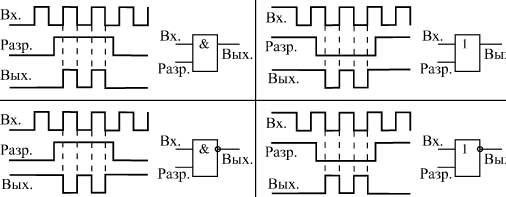
Figure 26.6 - Enable / disable the passage of signals
on the elements AND, AND-NOT, OR, OR-NOT
When using enable / disable elements, additional problems may arise when the signal from the output of the element goes to an input that responds to the signal front. At the moment of transition from the permission state to the prohibition state and from the prohibition state to the permission state, an additional front may appear in the output signal that is not connected in any way with the input signal (Figure 26.7). To prevent this from happening, you must adhere to the following simple rule: if the input responds to a positive edge, then in the prohibition state the output of the element must be zero, and vice versa.

Figure 26.7 - The appearance of an extra front during prohibition
input signal
Elements AND, AND-NOT, OR, OR-NOT can also be used as inverters or repeaters (Figure 26.8), for which it is necessary to combine the inputs or to the unused inputs to signal the desired level. The second is preferable, since combining the inputs not only increases the input current, but also slightly reduces the speed of the elements.

Figure 26.8 - Inverters and repeaters
Exclusive OR elements could also be attributed to the simplest elements, but the function performed by them is somewhat more complicated than in the case of the AND element or the OR element. All inputs of XOR elements are equal, however, none of the inputs can block other inputs by setting the output signal to unity or zero.
As already mentioned, the exclusive-OR function means the following: a unit at the output appears when only one input is present. If there are two or more units at the inputs, or if all inputs have zeros, then the output will be zero. The truth table of the two-input XOR element is given in table 24.2. The inscription in the domestic designation of the element Exclusive OR "\u003d 1" just means that the situation is highlighted when there is one and only one unit at the inputs.
From the point of view of mathematics, the element Exclusive OR performs the operation of the so-called summation modulo 2. Therefore, these elements are also called adders modulo two.
The main use of XOR elements, directly following from the truth table, is to compare two input signals. In the case when two units or two zeros arrive at the inputs (the signals coincide), a zero is generated at the output (see table 24.2). Typically, in this application, a constant level is applied to one input of an element, with which a time-varying signal arriving at another input is compared.
As an adder modulo 2, the XOR element is also used in parallel and sequential adders modulo 2, used to calculate cyclic checksums.
An important use of the EXCLUSIVE OR elements is a controlled inverter (Figure 26.9). In this case, one of the inputs of the element is used as a control, and an information signal is supplied to the other input of the element. If the control input is one, then the input signal is inverted; if zero, it is not inverted. Most often, the control signal is set at a constant level, determining the mode of operation of the element, and the information signal is pulsed. That is, the EXCLUSIVE OR element may change the polarity of the input signal or edge, or it may not change depending on the control signal.

Figure 26.9 - The element EXCLUSIVE OR as
controlled inverter
Another most important use of the EXCLUSIVE OR element is the formation of short pulses along any edge of the input signal (Figure 26.10).

Figure 26.10 - Highlighting the edges of the input signal
using the EXCLUSIVE OR element
In this case, it does not matter if the front of the input signal is positive or negative, a positive pulse is still generated at the output. The input signal is delayed using a capacitor or a chain of elements, and then the original signal and its delayed copy go to the inputs of the element EXCLUSIVE OR. In both schemes, two-input EXCLUSIVE OR elements in a non-inverting switch-on are also used as delay elements (zero is applied to an unused input). As a result of this conversion, we can talk about doubling the frequency of the input signal, since the output pulses follow twice as often as the input ones.
What is a number? NUMBER - one of the basic concepts of mathematics, originated in ancient times and gradually expanded and generalized. In connection with the counting of individual objects, the concept of positive integer (natural) numbers arose, and then the idea of \u200b\u200bthe infinity of the natural series of numbers: 1, 2, 3, Natural numbers are numbers used in counting objects. one

Story. In the excavations of the ancient people's camps, they found a wolf bone, on which 30,000 years ago, some ancient hunter inflicted fifty-five nicks. It is evident that, making these nicks, he counted on the fingers. The pattern on the bone consisted of eleven groups, five notches in each. At the same time, he separated the first five groups from the rest by a long line. Also in Siberia and in other places stone tools and ornaments made in the same distant era were found, on which there were also dashes and dots, grouped in 3, 5 or 7. The Celts - an ancient people who lived in Europe 2500 years ago ago, being the ancestors of the French and English, they considered twenty (two arms and two legs gave twenty fingers). Traces of this have been preserved in French, where the word "eighty" sounds like "four times twenty." Other nations, the ancestors of the Danes and the Dutch, Ossetians and Georgians, were considered twenty. 2
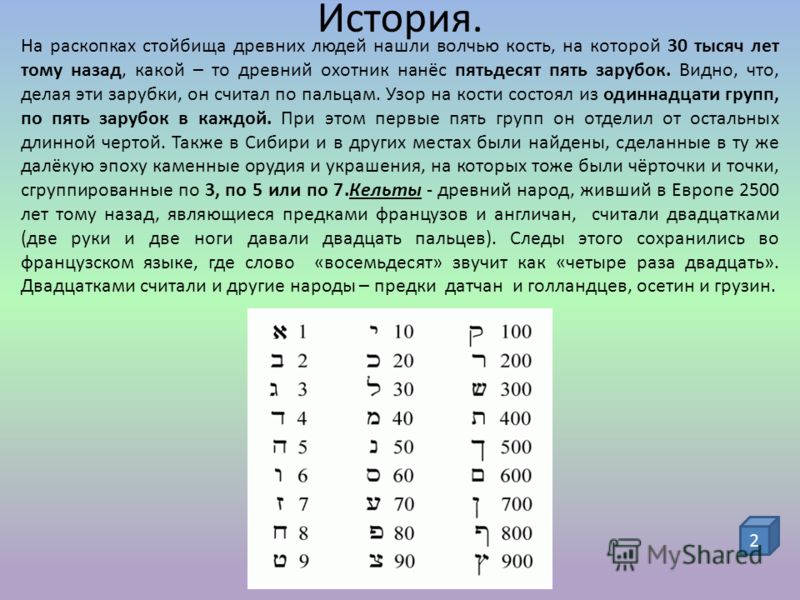

Even and odd numbers. An even number is an integer that is divisible without a remainder by 2: ..., 2, 4, 6, 8, ... An odd number is an integer that is not divisible without a remainder by 2: ..., 1, 3, 5, 7, 9, ... Pythagoras defining the number as energy and believed that through the science of numbers the secret of the Universe is revealed, for the number contains the secret of things. Pythagoras considered even numbers to be female and odd numbers to male: 2 + 3 \u003d 5 5 is a symbol of family, marriage. Even and odd numbers \u003d female and male numbers. 4
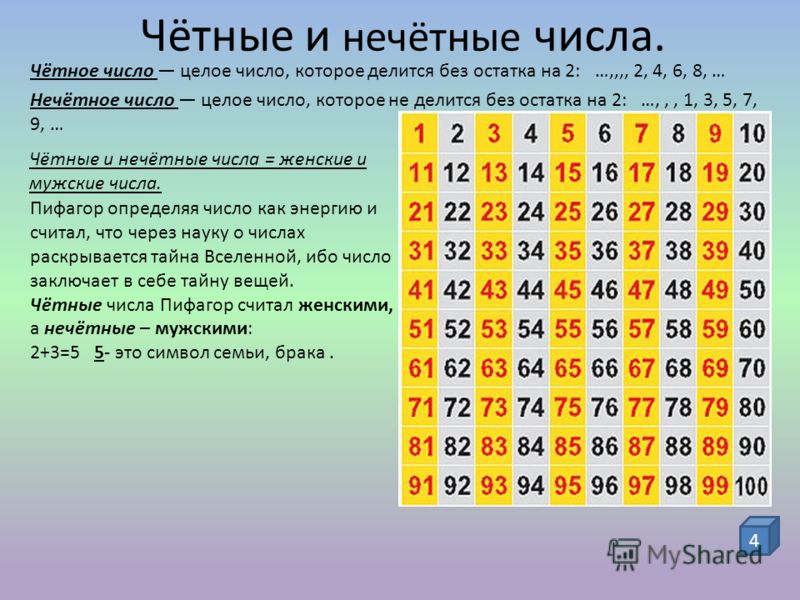
Simple and compound. A prime number is a natural number that has exactly two different natural divisors: one and itself. The sequence of primes begins as follows: 2, 3, 5, 7, 11, 13, 17, 19, 23, 29, 31, 37, 41, 43, 47, 53, 59, 61, 67, 71, 73, 79, 83, 89, 97, 101, 103, 107, 109, 113, 127, 131, 137, 139, 149, 151, 157, ... Compound numbers are numbers that have 3 or more divisors. The study of the properties of primes involved in number theory. Thus, all natural numbers greater than one are divided into simple and composite. 5
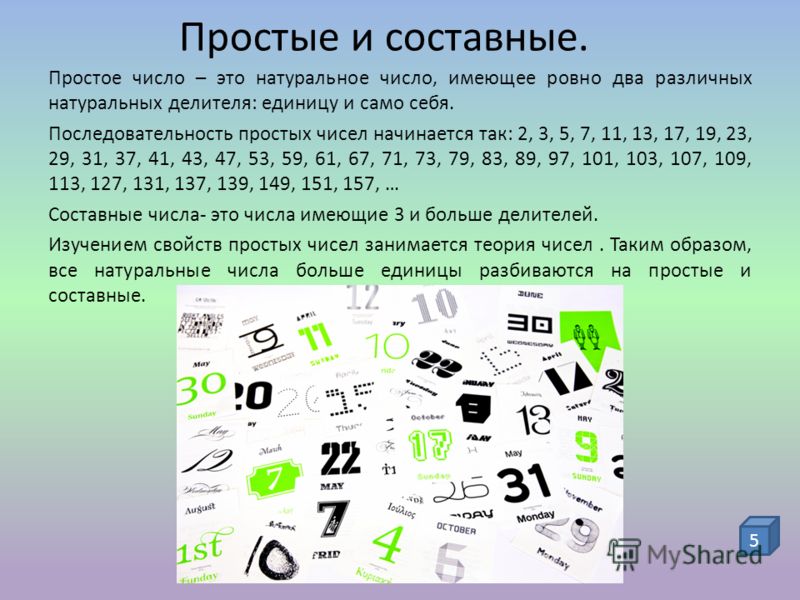
Perfect and imperfect numbers. Perfect numbers, positive integers, equal to the amount all of their regular (i.e., less than this number) divisors. For example, the numbers 6 \u003d and 28 \u003d are perfect. Until now (1976) not a single odd Owl is known. hours and the question of their existence remains open. Research on Owls. h. were begun by the Pythagoreans, ascribing a special mystical meaning to numbers and their combinations. Pythagoras called numbers imperfect, the sum of regular divisors, which are smaller than himself. 6
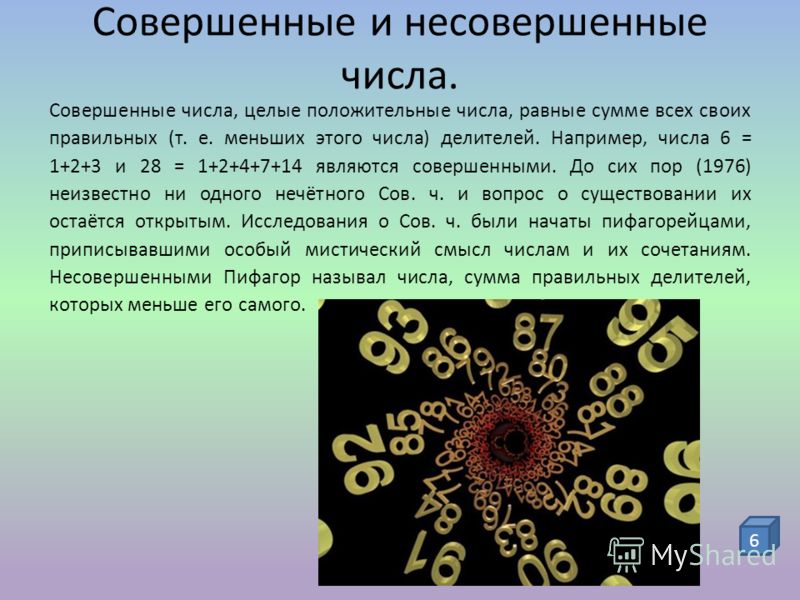
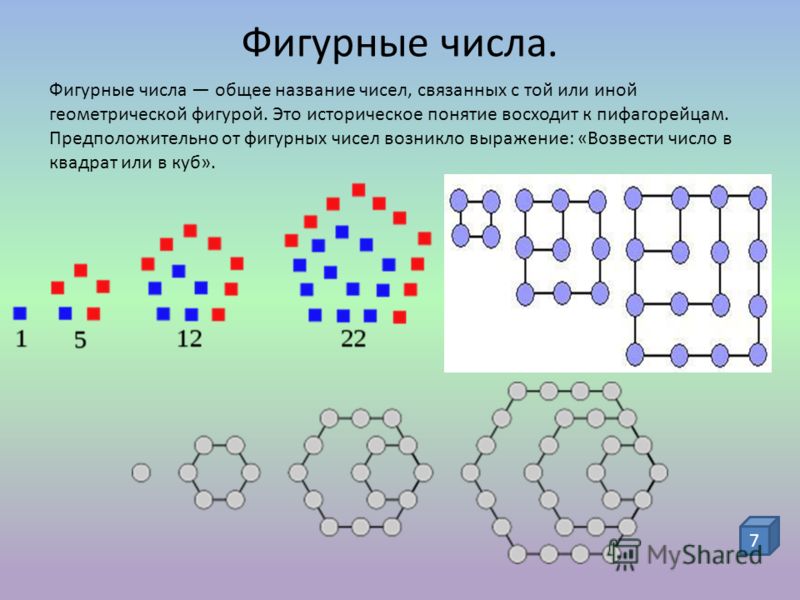
Magic numbers. The secrets of numbers attract people, make them delve into, understand, compare their findings with the real relationship of affairs. The figures in the ancient world were very kind. People who knew them were considered great, they were equated with deities. The simplest example is the absence in many countries of aircraft with tail number 13, floors and hotel rooms with number 13. 8
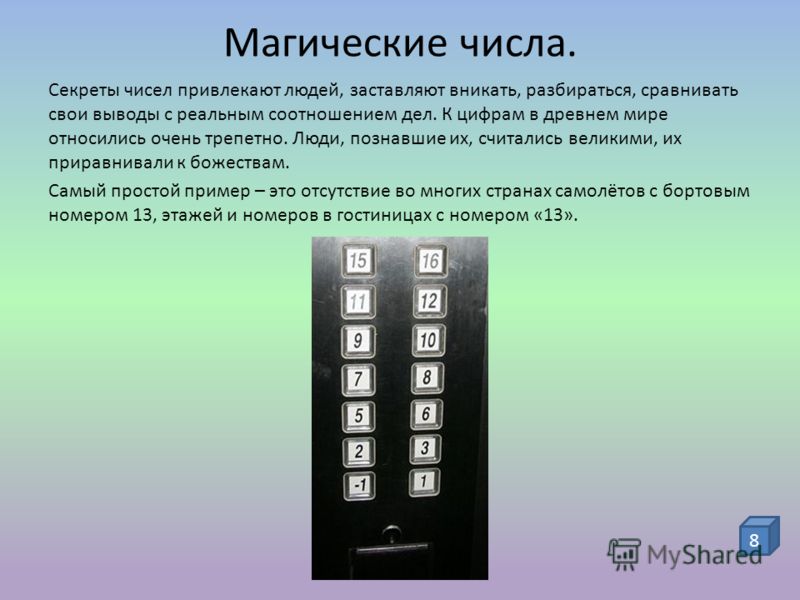 Magic row 2 - the number of balance and contrast, and supporting stability, mixing positive and negative qualities. 6 - A symbol of reliability. This is an ideal number, which is divided both by an even number (2) and an odd number (3), thus combining the elements of each. 8 - The number of material success. It means reliability, perfected, because it is represented by a double square. Divided in half, it has equal parts (4 and 4). If it is still divided, then the parts will also be equal (2, 2, 2, 2), showing a fourfold balance. 9 - The number of universal success, the largest of all numbers. Like three times the number 3, the nine transforms instability into aspiration. 10
Magic row 2 - the number of balance and contrast, and supporting stability, mixing positive and negative qualities. 6 - A symbol of reliability. This is an ideal number, which is divided both by an even number (2) and an odd number (3), thus combining the elements of each. 8 - The number of material success. It means reliability, perfected, because it is represented by a double square. Divided in half, it has equal parts (4 and 4). If it is still divided, then the parts will also be equal (2, 2, 2, 2), showing a fourfold balance. 9 - The number of universal success, the largest of all numbers. Like three times the number 3, the nine transforms instability into aspiration. 10






